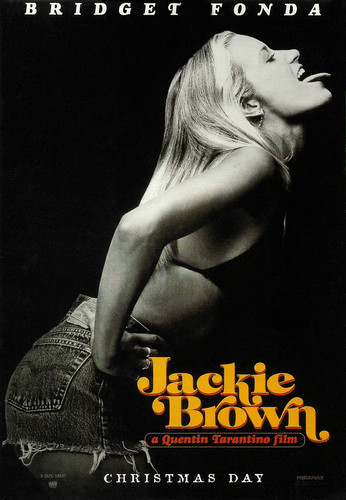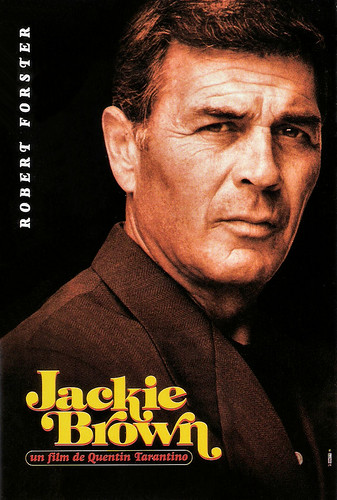
Vintage postcard in the Cinemascope Collection, no. 137. Pam Grier as Jackie Brown in Jackie Brown (Quentin Tarantino, 1997).

Vintage postcard in the Cinemascope Collection, no. 138. Robert Forster as Max Cherry in Jackie Brown (Quentin Tarantino, 1997).
Elevating a crime novel to a form of sociological comedy
Jackie Brown (Quentin Tarantino, 1997) is the first feature-length film directed by Quentin Tarantino that was based on another work. While adapting Elmore Leonard’s 'Rum Punch' into a screenplay, Tarantino changed the ethnicity of the main character from white to black, as well as renaming her from Burke to Brown, titling the screenplay 'Jackie Brown'.
Tarantino hesitated to discuss the changes with Leonard, finally speaking with the author as the film was about to start shooting. Leonard loved the screenplay. He considered it not only the best of the twenty-six screen adaptations of his novels and short stories but also stated that it was possibly the best screenplay he had ever read.
In his 1997 review of Tarantino’s third film, Roger Ebert wrote: “This is the movie that proves Tarantino is the real thing, and not just a two-film wonder boy’ It's not a retread of Reservoir Dogs or Pulp Fiction, but a new film in a new style, and it evokes the particular magic of Elmore Leonard - who elevates the crime novel to a form of sociological comedy.
There is a scene here that involves the ex-con Louis (Robert De Niro) and Ordell's druggie mistress (Bridget Fonda) discussing a photograph pinned to the wall, and it's so perfectly written, timed and played that I applauded it. Tarantino has a lot of good scenes in this movie.
The scene where one character lures another to his death by tempting him with chicken and waffles. The scene where a nagging woman makes one suggestion too many. The scene where a man comes around in the morning to get back the gun a woman borrowed the night before. The moment when Jackie Brown uses one line of dialogue, perfectly timed, to solve all of her problems.”

French postcard, no. 655. Samuel L. Jackson as Ordell Robbi in Jackie Brown (Quentin Tarantino, 1997).

French postcard, no. 657. Robert Forster as Max Cherry in Jackie Brown (Quentin Tarantino, 1997).
Tarantino's gift is casting
If Quentin Tarantino's strengths are dialogue and plotting, his gift is casting. Pam Grier, goddess of 1970s grindhouse films who, by the 1990s, wasn’t exactly seeing the plum roles pour in, here finds just the right note for Jackie Brown, a tired and desperate flight attendant for a low-rent airline.
Jackie makes a little scratch on the side by smuggling money for her firearms dealer boss (Samuel L. Jackson), but she gets busted. Robert Forster, another actor who’d practically been forgotten at the time, has the role of a career as bail bondsman Max Cherry. Max is a plausible professional, not a plot stooge. Matter of fact about his job and the law, Cherry gets her out of jail and instantly falls in love with her.
Jackson, as Ordell, does a harder, colder version of his hit man in Pulp Fiction, and once again uses the N-word like an obsession or a mantra. Robert De Niro, still in a longtime convict's prison trance, plays Louis as ingratiatingly stupid. Bridget Fonda's performance is so good, it's almost invisible; her character's lassitude and contempt coexist with the need to be high all the time.
Songs by a variety of artists are heard throughout the film, including The Delfonics' 'La-La Means I Love You' and 'Didn't I (Blow Your Mind This Time)', Bill Withers' 'Who Is He', The Grass Roots' 'Midnight Confessions', Johnny Cash's 'Tennessee Stud', Bloodstone's 'Natural High', and Foxy Brown's '(Holy Matrimony) Married to the Firm'.
There are several songs included that were featured in blaxploitation films as well, including Bobby Womack's 'Across 110th Street', from the film Across 110th Street (Barry Shear, 1972), and Pam Grier's 'Long Time Woman', from her film The Big Doll House (Jack Hill, 1971). The original soundtrack also features separate tracks with dialogue from the film. Instead of using a new film score, Tarantino incorporated Roy Ayers' funk score from the film Coffy (Jack Hill, 1973).

French postcard by Sonis, no. C 867. Photo: Miramax / A Band Apart / BAC Films. Bridget Fonda as Melanie Ralston in Jackie Brown (Quentin Tarantino, 1997). Caption: Christmas Day.

French promotion card by BacFilms. Michael Keaton as Ray Nicolette in Jackie Brown (Quentin Tarantino, 1997).
A love letter to the second chance
Jackie Brown (1997) received positive reviews and grossed $74.7 million worldwide on a $12 million budget. Roger Ebert: "You savour every moment of Jackie Brown. Those who say it is too long have developed cinematic attention deficit disorder. I wanted these characters to live, talk, deceive and scheme for hours and hours."
It earned a nomination for the Academy Award for Best Supporting Actor for Robert Forster, and Golden Globe Award nominations for Samuel Jackson and Pam Grier. The film revitalised the careers of Grier and Forster, neither of whom had been cast in a lead role for many years.
Jackie Brown also attracted criticism for its use of the racial slur ‘nigger’, which is used 38 times. During an interview with Manohla Dargis, Tarantino said: "The minute any word has that much power, as far as I'm concerned, everyone on the planet should scream it. No word deserves that much power."
Director Spike Lee: "I'm not against the word, and I use it, but not excessively. And some people speak that way. But, Quentin is infatuated with that word. What does he want to be made – an honorary black man?" Lee took his concerns to the film's producers, Harvey Weinstein and Lawrence Bender. But in Tarantino’s later films Django Unchained (2012) and The Hateful Eight (2015), the word was even used more.
In 2023, Time magazine chose Jackie Brown as one of the 10 best films of the 1990s. In her comment, Time’s Stepanie Zacharek concluded: "Yet the movie is filled with love, chiefly Tarantino’s love for Forster and Grier, two actors he was nuts about as a kid, and they’re glorious here. Jackie Brown is Tarantino’s warmest movie, a love letter to the second chance. Everybody deserves one.” And is Jackie Brown (1997) Quentin Tarantino’s most underrated film? We think so.

French postcard, no. 654. Photo: publicity still for Jackie Brown. (Quentin Tarantino, 1997) with Robert De Niro as Louis Gara.

French promotion card by BacFilms. Robert Forster in Jackie Brown (Quentin Tarantino, 1997).

British postcard by Heroes Publishing LTD, London, no. SFC 3308. Pam Grier in Jackie Brown (Quentin Tarantino, 1997).
Sources: Stephanie Zacharek (Time), Roger Ebert (Roger Ebert.com), Claudio Carvalho (IMDb), Wikipedia and IMDb.
No comments:
Post a Comment